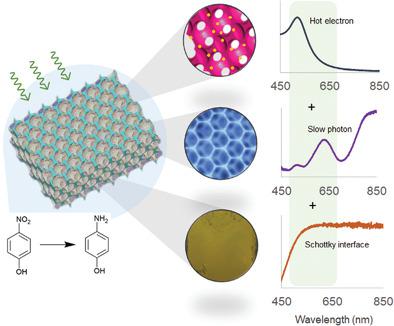当前位置:
X-MOL 学术
›
Adv. Mater. Interfaces
›
论文详情
Our official English website, www.x-mol.net, welcomes your
feedback! (Note: you will need to create a separate account there.)
Semiconducting Metal Oxide Photonic Crystal Plasmonic Photocatalysts
Advanced Materials Interfaces ( IF 4.3 ) Pub Date : 2020-02-24 , DOI: 10.1002/admi.201901805 Gillian Collins 1, 2, 3 , Alex Lonergan 1 , David McNulty 1 , Colm Glynn 1 , Darragh Buckley 1 , Changyu Hu 1 , Colm O'Dwyer 1, 2, 3, 4
Advanced Materials Interfaces ( IF 4.3 ) Pub Date : 2020-02-24 , DOI: 10.1002/admi.201901805 Gillian Collins 1, 2, 3 , Alex Lonergan 1 , David McNulty 1 , Colm Glynn 1 , Darragh Buckley 1 , Changyu Hu 1 , Colm O'Dwyer 1, 2, 3, 4
Affiliation

|
Plasmonic photocatalysis has facilitated rapid progress in enhancing photocatalytic efficiency under visible light irradiation. Poor visible‐light‐responsive photocatalytic materials and low photocatalytic efficiency remain major challenges. Plasmonic metal–semiconductor heterostructures where both the metal and semiconductor are photosensitive are promising for light harvesting catalysis, as both components can absorb solar light. Efficiency of photon capture can be further improved by structuring the catalyst as a photonic crystal. Here, the synthesis of photonic crystal plasmonic photocatalyst materials using Au nanoparticle‐functionalized inverse opal (IO) photonic crystals is reported. A catalyst prepared using a visible‐light‐responsive semiconductor (V2O5) displayed over an order of magnitude increase in reaction rate under green light excitation (λ = 532 nm) compared to no illumination. The superior performance of Au‐V2O5 IO is attributed to spectral overlap of the electronic bandgap, localized surface plasmon resonance, and incident light source. For the Au‐TiO2 catalyst, despite coupling of the LSPR and excitation source at λ = 532 nm, this is not as effective in enhancing photocatalytic activity compared to carrying out the reaction under broadband visible light, which is attributed to improved photon adsorption in the visible by the presence of a photonic bandgap, and exploiting slow light in the photonic crystal to enhance photon absorption to create this synergistic type of photocatalyst.
中文翻译:

半导体金属氧化物光子晶体等离子体光催化剂
等离子体光催化促进了在可见光照射下提高光催化效率的快速进展。可见光响应性差的光催化材料和低的光催化效率仍然是主要挑战。金属和半导体都是光敏性的等离子金属-半导体异质结构有望用于光收集催化,因为这两种成分都可以吸收太阳光。通过将催化剂构造为光子晶体,可以进一步提高光子捕获的效率。此处报道了使用Au纳米粒子官能化的反蛋白石(IO)光子晶体合成光子晶体等离激元光催化剂材料的方法。使用可见光响应半导体(V 2 O 5与未照明相比,在绿光激发下(λ= 532 nm)反应速率增加了一个数量级。Au‐V 2 O 5 IO的卓越性能归因于电子带隙的光谱重叠,局部表面等离子体激元共振和入射光源。对于Au‐TiO 2催化剂,尽管LSPR和激发源在λ= 532 nm处偶合,但与在宽带可见光下进行反应相比,在增强光催化活性方面不那么有效,这归因于改善了在纳米管中的光子吸附通过存在光子带隙可以看到可见光,并利用光子晶体中的慢光来增强光子吸收,从而创建这种协同类型的光催化剂。
更新日期:2020-02-24
中文翻译:

半导体金属氧化物光子晶体等离子体光催化剂
等离子体光催化促进了在可见光照射下提高光催化效率的快速进展。可见光响应性差的光催化材料和低的光催化效率仍然是主要挑战。金属和半导体都是光敏性的等离子金属-半导体异质结构有望用于光收集催化,因为这两种成分都可以吸收太阳光。通过将催化剂构造为光子晶体,可以进一步提高光子捕获的效率。此处报道了使用Au纳米粒子官能化的反蛋白石(IO)光子晶体合成光子晶体等离激元光催化剂材料的方法。使用可见光响应半导体(V 2 O 5与未照明相比,在绿光激发下(λ= 532 nm)反应速率增加了一个数量级。Au‐V 2 O 5 IO的卓越性能归因于电子带隙的光谱重叠,局部表面等离子体激元共振和入射光源。对于Au‐TiO 2催化剂,尽管LSPR和激发源在λ= 532 nm处偶合,但与在宽带可见光下进行反应相比,在增强光催化活性方面不那么有效,这归因于改善了在纳米管中的光子吸附通过存在光子带隙可以看到可见光,并利用光子晶体中的慢光来增强光子吸收,从而创建这种协同类型的光催化剂。











































 京公网安备 11010802027423号
京公网安备 11010802027423号